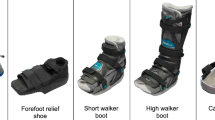Summary
The present is a long-term follow-up study of patients who underwent triple arthrodesis for a variety of pathologic alterations. Utilizing a new method for both the qualitative and quantitative measurement of foot-ground pressure patterns, these patterns were recorded in forty control feet and twenty-six operated feet. In the patient group, less equal distribution of body weight between both feet was observed in comparison to the control group. In the latter, the main load underneath the foot was distributed underneath the forefoot and heel, while in the patient group, this load distribution had persistently shifted to the midfoot and heel, thus producing a completely different foot-ground pressure pattern. Furthermore, under the forefoot, the main load was located under the medial two rays in the control group, shifting towards the lateral rays in the patient group. The talo-navicular joint had the highest rate of non-union, but no positive correlation between that finding and persistent pain was found. Feet affected by neurological disorders often became pain-free following surgery, but none of the patients showed such post-traumatic relief.
Zusammenfassung
Die Verteilung des Fußbodendruckes bei vierzig normalen und sechsundzwanzig operierten Füßen wurde qualitativ und quantitativ untersucht und verglichen. Die Patientengruppe bestand aus Fällen, bei welchen eine Arthrodese der subtalaren Gelenke zwischen 1958 und 1976 für verschiedene Pathologien vollzogen wurde. In der Patientengruppe zeigte der Fußbodendruck eine weniger symmetrische Verteilung zwischen den beiden Füßen, während am Fuß selbst die Druckverteilung bei der Patientengruppe einen völlig anderen Auswurf zeigte. Die Unterschiede zwischen den beiden Gruppen waren statistisch höchst signifikant. Das talo-naviculare Gelenk bewies den höchsten Prozentsatz von Pseudarthrosen, jedoch keine positive Korrelation zwischen Fußschmerzen und dieser Pseudarthrose. Füße, die wegen neurologischer Krankheiten operiert wurden, waren nach der Operation oft schmerzfrei, während post-traumatische Füße nie schmerzfrei wurden.
Similar content being viewed by others
References
Arcan M, Brull MA (1976) A fundamental characteristic of the human body and foot, the foot-ground pressure pattern. J Biomech 9:453–457
Arcan M, Brull M, Simkin A (1976) Mechanical parameters describing the standing posture, based on the foot-ground pressure pattern. In: Komi PV (ed) Biomechanics 5B, Proc 5th Int Congr Biomech. University Park Press, pp 415–425
Bernan A (1977) Long-term results following Lambrinudi arthrodesis. J Bone Jt Surg 59-A:473–479
Crego CH Jr, McCarroll HR (1938) Recurrent deformities in stabilizing paralytic feet. J Bone Jt Surg 20:609–620
Dekelver L, Fabry G, Mulier JC (1980) Triple arthrodesis and Lambrinudi arthrodesis. Arch Orthop Traumat Surg 96:23–30
Drew AJ (1951) The late results of arthrodesis of the foot. J Bone Jt Surg 33-B:496–502
El Ghawabi MH (1978) Centripedal compression triple arthrodesis. Acta Orthop Scand 49:306–309
Friedenberg ZB (1948) Arthrodesis of the tarsal bones. Arch Surg 57:162–170
Ingram AJ, Hundley JM (1951) Posterior bone block of the ankle for paralytic equinus. J Bone Jt Surg 33-A:679–691
Kalamachi A, Evans JG (1977) Posterior subtalar fusion. J Bone Jt Surg 59-B:287–289
Lambrinudi C (1933) A method of correcting equinus and calcaneous deformities at the sub-astragaloid joint. Proc R Soc Med 26:788–791
Murray MP, Seireg AA, Sepic SB (1975) Normal postural stability and steadiness: Quantitative assessment. J Bone Jt Surg 57-A:510–516
MacKenzie JG (1959) Lambrinudi's arthrodesis. J Bone Jt Surg 41-B:738–748
Patterson RL, Parrish FF, Hathaway EN (1950) Stabilizing operations on the foot. J Bone Jt Surg J Bone Jt Surg 32-A:1–26
Pforringer W, Matzen K, Hinterberger J (1980) Electronic studies of gait disturbances. Arch Orthop Traumat Surg 96:115–122
Sharma M, Dhanendran M, Hutton WC, Corbett M (1979) Changes in load bearing in the rheumatoid foot. Ann Rheum Dis 38:549–552
Tschui F (1962) Resultate der Fuß-Arthrodese-Arthrorhise-Operation nach Lambrinudi. Arch Orthop Unfall Chir 54:215–223
Williams PF, Menelaus MB (1977) Triple arthrodesis by inlay grafting. A method suitable for the undeformed or valgus foot. J Bone Jt Surg 59-13:333–336
Author information
Authors and Affiliations
Rights and permissions
About this article
Cite this article
Stein, H., Simkin, A. & Joseph, K. The foot-ground pressure distribution following triple arthrodesis. Arch. Orth. Traum. Surg. 98, 263–269 (1981). https://doi.org/10.1007/BF00378879
Received:
Issue Date:
DOI: https://doi.org/10.1007/BF00378879




